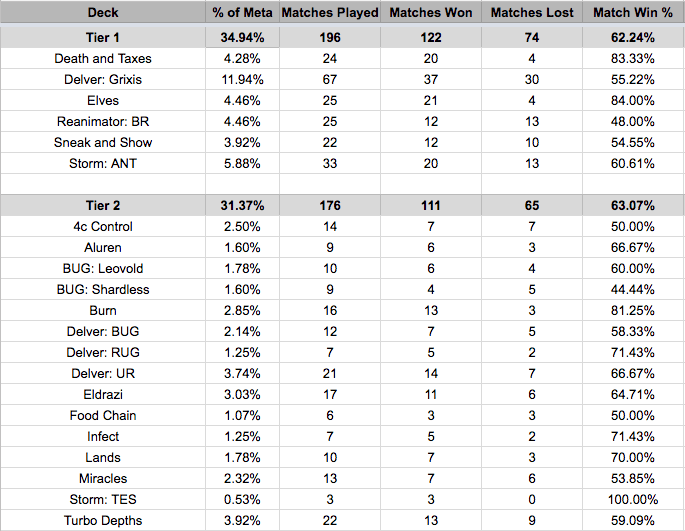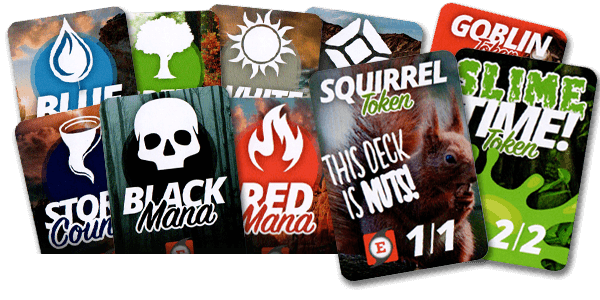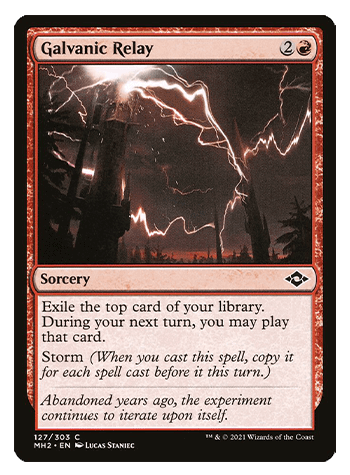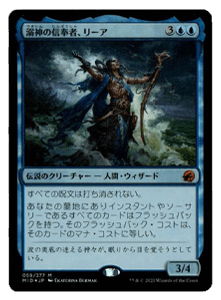In the past I wrote an article on The EPIC Storm (TES) and Ad Nauseam Tendrils (ANT), I believe it’s about time we revisit this topic due to changes in the metagame. I’ve seen a number of forum posts and general questions on the topic, let’s provide some clarity.
Deck Lists
TES – GP: Las Vegas – Bryant Cook
- 4 Burning Wish
- 4 Infernal Tutor
- 4 Brainstorm
- 4 Ponder
- 4 Gitaxian Probe
- 3 Cabal Therapy
- 3 Duress
- 1 Empty the Warrens
- 1 Ad Nauseam
ANT – MTGO Legacy League – Control4Daze
- 4 Infernal Tutor
- 4 Brainstorm
- 4 Ponder
- 4 Gitaxian Probe
- 2 Preordain
- 3 Cabal Therapy
- 3 Duress
- 2 Past in Flames
- 1 Dark Petition
- 1 Tendrils of Agony
- 1 Ad Nauseam
- 4 Polluted Delta
- 4 Scalding Tarn
- 2 Underground Sea
- 1 Volcanic Island
- 1 Badlands
- 2 Island
- 1 Swamp
Differences between TES & ANT
The EPIC Storm
- 13 Lands
- Rite of Flame
- Burning Wish
- Empty the Warrens (sometimes in ANT lists if they don’t play Ad Nauseam)
- Chrome Mox
Ad Nauseam Tendrils
- 14-15 Lands
- Cabal Ritual
- Past in Flames (Main deck)
- Tendrils of Agony (Main deck)
- Preordain (due to less playable tutors)
Above, you can see the main deck differences outlined. To be honest, it doesn’t look like much of a difference between the two – somewhat comparable to the flavors of Delver of Secret decks. That said, like the tempo variants, they aren’t the same. For example, RUG (Canadian Threshold) Delver is more aggressive than BUG (Team America) Delver.
We’re looking at the same exact thing when it comes to The EPIC Storm and Ad Nauseam Tendrils. To generalize the decks, TES is the aggressor while ANT is more controlling. What I mean by this is that TES tends to be faster and relies on probabilistic kills where ANT is slower and plays to guaranteed kills.
“How can that be? They share 80% of the same cards, even the same storm engines AND win conditions?”
Just because they share the same cards doesn’t mean they function in a similar matter, their differences are what define this. Cards like Chrome Mox and Rite of Flame are inherently faster due to their converted mana cost, both cards provide a quick turnaround of a single mana. Where Cabal Ritual is also a quick turnaround of a mana, its cost upfront is a lot more – because of this, it’s better to cast Cabal Ritual in the “mid-game” on turn three. This way you get maximum value from your Cabal Ritual‘s secondary ability, while it’s certainly possible to achieve Threshold on turn two, it’s just not very common.
Due to this, you’ll see that TES is built to be faster than ANT. TES aims to combo out on turns one to two using high probabilities of killing the opponent by casting Empty the Warrens or Ad Nauseam, both of these cards by their very nature are “chance” cards. When casting these cards, you’re often doing the math to see how likely it is for your opponent to draw their out (2/53 in 2 draws) or revealing cards to Ad Nauseam and counting how many cards are left in the deck that can kill you versus winning flips (this essentially breaks down to a game of Blackjack). ANT takes a different approach, it likes guaranteed kills without any math or probabilities – it’s much safer, but considerably slower. Due to having more cards that generate additional mana (Cabal Ritual), the deck often tries to win the game with Past in Flames by recurring the same additional mana “ritual effects” and then counting to nine before casting a lethal Tendrils of Agony. Similarly, ANT is also known for its “tutor chains” of casting Infernal Tutor for Infernal Tutor for Infernal Tutor for Tendrils of Agony which can be accomplished by having lots of mana.
While both decks have Ad Nauseam, TES is actually “the Ad Nauseam deck” where ANT is considered to be “the Past in Flames deck”. This is because of the cards outlined above, TES has a much lower mana curve. You’ll see that there’s a single card that isn’t Ad Nauseam that costs more than two, in addition to that, there’s Chrome Mox! A card that is terrific to reveal off of Ad Nauseam has its an initial mana source that allows you to “get going” post-Ad Nauseam. Rite of Flame having a cheaper upfront cost is also better for Ad Nauseam, not only because of its converted mana cost, but because you don’t need two initial mana sources to cast it after an Ad Nauseam. Believe it or not, this is a very real consideration. These are a few reasons why TES doesn’t play Cabal Ritual, the others being that Cabal Ritual (like I mentioned above) has difficulty of reaching Threshold in the early game – this is where TES lives. Another reason being the anti-synergy when paired with Chrome Mox and Burning Wish, with Cabal Ritual, you would like your cards going to the graveyard and not exile.
TES has a tough time supporting a card like Past in Flames in the main deck, mostly because its secondary ritual (Rite of Flame) doesn’t produce as much mana as Cabal Ritual. This is relevant because when you cast Past in Flames floating one red mana and one black mana, casting a single Rite of Flame and a single Dark Ritual into Infernal Tutor leaves you a mana short of your storm card. There’s also the issue of requiring two different colors of mana post-Past in Flames, with ANT, all you’ll ever need is black mana for Dark Ritual, Cabal Ritual, Infernal Tutor into Tendrils of Agony. Where with TES, you’ll need red and black mana, then you’ll likely need an additional two mana. The reason for the additional two mana is for Burning Wish before the Tendrils of Agony, alternatively, you could cast Empty the Warrens after your Past in Flames (I’ve certainly done this) but its not as common. Having such an easy time with only requiring black mana with the later-game ritual, is really what makes ANT “the Past in Flames deck.”
That said, its really a matter of function and goals, right? It depends on what your deck is trying to do. If TES is trying to be “the Past in Flames deck”, its not likely going to get many wins, but if you’re casting Ad Nauseam on the first turn – I’d much rather be the deck with Chrome Mox in it. Let’s take a quick look at how the game plans for these decks break down:
The EPIC Storm
- Plan A: Ad Nauseam
- Plan B: Empty the Warrens
- Plan C: Tutor Chain
- Plan D: Past in Flames
Ad Nauseam Tendrils
- Plan A: Past in Flames
- Plan B: Tutor Chain
- Plan C: Ad Nauseam
- Plan D: Empty the Warrens (if they play it)
Other than the difference between speed and secondary rituals, TES has the flexibility and raw power of Burning Wish. With TES players gain the ability to answer a game one Chalice of the Void or Thalia, Guardian of Thraben using Meltdown or Massacre. There’s also the options of different choices between Dark Petition, Telemin Performance, Tendrils of Agony or Past in Flames. Using this red sorcery, you’re able to overcome unwinnable scenarios in game one that would otherwise be impossible such as Gaddock Teeg or having your Tendrils of Agony removed by Deathrite Shaman. In order for ANT to increase its threat density to match TES, it plays additional copies of cards like Past in Flames or Dark Petition. The downside of playing additional copies of these cards is that it hurts Ad Nauseam a lot and not great against other fast decks. The benefit is that you gain an edge against traditional blue control decks.
One thing that’s often not discussed between the two decks is how each deck uses its resources. TES is a deck that really pushes its life-total as a tool, between Gitaxian Probe, Ad Nauseam, fetchlands, and of course opposing threats racing against Goblins. Games become interesting. That said, its graveyard is a resource it doesn’t rely on – TES uses Rite of Flame, its fourth plan (Past in Flames), and sometimes the flashback on Cabal Therapy. ANT is really the inverse of TES in this respect, its graveyard is its primary tool between Cabal Ritual and Past in Flames. Its life-total is its third resource, which at the point if they’re going for Ad Nauseam – they’re either very far ahead or desperate.
Similarities between TES & ANT
Deck Similarities
- Cantrip Suite (Brainstorm, Ponder, and Gitaxian Probe)
- Fast Mana (Lotus Petal, Lion’s Eye Diamond, and Dark Ritual)
- Disruption Package (Duress and Cabal Therapy)
- Haymakers (Infernal Tutor and Ad Nauseam)
- Lands (Polluted Delta, Bloodstained Mire, Scalding Tarn, Island, Swamp, Underground Sea, Volcanic Island, and Badlands)
Play Similarities
- Win the majority of their games with Tendrils of Agony.
- Capable of winning the game on either turn 1 or turn 6.
- Are good against Blood Moon, Stifle, and Wasteland effects.
- Both decks are powerful enough to plow through Force of Will.
- Use Ad Nauseam, “tutor chains”, Empty the Warrens, and Past in Flames to win games.
- Pilots are forced to learn how to properly name cards for Cabal Therapy.
- Require tremendous ability to bluff and play confidently.
Warning: I know this isn’t everything, there’s bound to be plenty that I missed. If you feel strongly about one that I might’ve missed, please comment below.
This is a lot of cards to have overlapping. Sometimes in the mix of “No! My storm variant is better!” this concept gets lost. When it comes down to it, a lot of people that play the storm archetype switch back and forth between decks – there’s no need to alienate anyone. There are periods of times when one deck is better than the other, but I believe we should keep an open mind and re-evaluate from time to time.
I believe that trying each storm variant will only open people’s perspectives and create new concepts for the decks to both become better.
Which leads me to my next section…
Merging TES & ANT
Over the last five years TES and ANT have been merging slowly, I’ve tried a handful of hybrid variants over the years. You could even say that it started when TES cut Silence and truly became a Grixis deck, at the time it was playing Cabal Therapy (in fewer numbers) paired with Gitaxian Probe. That’s when the current lists started to realize the synergies of Empty the Warrens paired with Cabal Therapy. Then TES cut the gold lands all together, moved to fetchlands and later in time added a basic Swamp – current lists are even playing an Island!
It’s not all one-sided, there are plenty of ANT lists running around trying to mimic the synergies of Empty the Warrens and Cabal Therapy. But then there’s people on the ANT side, moving even closer to TES, such as Caleb Scherer or Kai Sawatari. Caleb is playing three copies of Chrome Mox in his ANT list after spending some time during the Dig Through Time era playing TES. Kai played a few copies of Rite of Flame, Burning Wish and a silver-bullet sideboard at Grand Prix: Las Vegas.
I strongly believe we’ll continue to see these decks become more similar as time goes on, will they ever become one? I’m unsure. I don’t think the current card selection offers what that needs in order for it to happen, but we’re close. Likely what needs to happen is a playable “ritual effect” needs to be printed that’s better than Rite of Flame or Cabal Ritual. Similarly, if something better than Burning Wish or Dark Petition, it could create a positive change.
Metagame vs Storm
With the current metagame, you can break decks into four generic categories: Chalice of the Void decks, Thalia, Guardian of Thraben decks, Force of Will Decks, and other unfair decks. Sure, there’s plenty of decks that fall in-between the cracks of this, but when you’re looking at a generic metagame breakdown – this is an easy way to do it.
When looking at this, in three out of four of these categories, its best to be as fast as possible (in my opinion). The exception being Force of Will decks, which require more play to them. If you view at my report from Grand Prix: Las Vegas you’ll see that I faced four Chalice of the Void decks (winning against all of them) and six other unfair decks.
ANT shines against very slow midrange blue decks, the issue I have with that is that the metagame is no longer flush with them. There’s Miracles and 4c Control, which according to MTG Goldfish, make up roughly 12% of the metagame. I also believe its fair to say that the online metagame also contains a higher representation of these decks than paper magic.
Right now is one of those times where TES is more favored against the metagame than ANT, I highly encourage people to give it a fair shot. Its not as if TES is a dog against those control decks either as you can see from my results below (Since the banning of Sensei’s Divining Top):


Stay Tuned!
Hey everyone, I know the website has been devoid of articles since the banning of Sensei’s Divining Top. I was trying to keep my deck lists out of sight and mind until GP:Vegas, which meant asking the other website contributors to take a break. I have some great news for you, they’re off hiatus and writing articles as I type this! I’m expecting new articles from AJ Kerrigan, Alex Poling and Alexandre Richard within the next week.
There’s a bunch of great TES content coming down the pipeline (if that’s something you’re interested in)! Thanks for reading.
Until next time, keep storming!
















